Conveyor belt systems have been responsible for over 80 serious or fatal accidents in the U.S. over the last 20 or so years. According to a report featured by the American Society of Safety Engineers, a disproportionate number of conveyor related accidents involve a specific component of the system; the pulleys. Roughly 48% of accidents are reported to involve pulleys. Understanding where they are and what function they perform in a particular system can go a long way to ensure that personnel remain safe during normal operation, maintenance, and cleaning, during which 30% of accidents occur.
Types of Conveyor Belt Systems
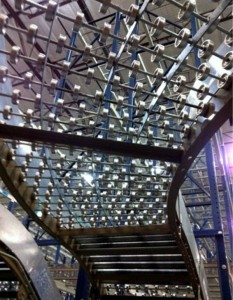
Gravity Driven
Gravity-driven conveyors have no mechanical or electrical power source. The momentum of the product and the force of gravity move product along these conveyors.
Gravity Wheel Conveyor – The gravity wheel conveyor is a skate wheel gravity flow system. Both curved and straight sections are used in this system. This type of conveyor uses a pattern of free turning wheels as the conveying surface.
Gravity Roller Conveyor – The gravity roller conveyor is a roller-to-roller gravity flow system. These are light-load conveyors used for handling product. The conveyor beds are comprised of two side channels which support free turning rollers.
Flat Belt
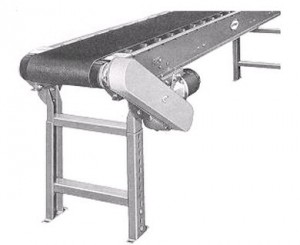
There are many different types of flat belt conveyors used to move product throughout the distribution center. The four most common types of flat belt conveyors are the slider bed, belt-on-roller, meter belt, and brake.
Slider Bed Conveyor – Slider bed conveyors operate by pulling a belt over the top surface of a box channel bed. Product is carried directly on the belt surface. Fixed speed center drives and fixed speed end drives are used to drive the slider bed conveyor. Center drives can be used for one or two-way operation, while end drives are designed for one-way operation only. Slider bed conveyors are usable in incline, decline, or horizontal applications. Slider bed conveyors are adaptable for use with many other types of powered and gravity conveyors.
Belt-On-Roller Conveyor – Belt-on-roller conveyors carry products directly on the belt. The belt rides on the surface of carrier rollers mounted in the bed. Center drive units can be used in one or two-way operation, and end drive units are suitable for one-way operation only. Belt-on-roller units can be used for incline, decline, or horizontal operations. They can be used in conjunction with many other powered or gravity conveyors.
Meter Belt – A meter belt conveyor is a belt conveyor with two belts and a common drive. The discharge belt runs faster than the induct belt to allow spacing of conveyed products. It is primarily used prior to merge or induct units. Meter belts are available with a brake/clutch option that is either air or electric-operated.
Brake Belt – The brake belt is used to stop product flow and allow accumulation of the product prior to product discharge onto a merge unit. Brake belts are electrically operated and are available with a brake or a clutch/brake.
Live Roller
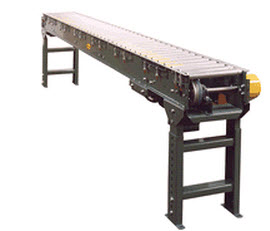
The live roller type conveyor is a conveyor type on which product is moved by rotation of the carrier rollers.
Typical Live Roller Conveyors – Here, the carrier rollers are rotated by friction with a powered belt, which is pressed against the underside of the carrier rollers by adjustable pressure rollers. Friction between belt and carrier rollers, and thus driving force of the carrier rollers in any desired area, can be varied by adjusting the height of the pressure rollers under the belt at that location. This conveyor may be used on inclines or declines, which do not exceed five degrees from horizontal.
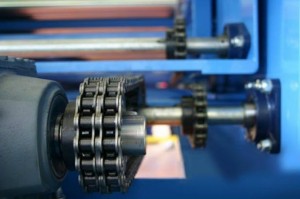
Chain-Driven Live Roller – The chain-driven live roller is a transportation-type conveyor. They use cycloidal tooth sprockets welded on one end. Cycloidal sprockets have thicker teeth than regular sprockets, which allows the chain to better mesh with the sprocket teeth. Guards are mounted above and below all chain and sprockets for safety. Standard tooth sprockets are used on end cap rollers, because the chain wraps 180 degrees around the sprocket.
Sawtooth Merge – The sawtooth merge is a live roller conveyor. Product is moved downstream on the conveyor by multiple rotating carrier rollers. The carrier rollers are powered by a continuous flat belt, which is located beneath the rollers in the center of the conveyor. Pressure rollers press the flat belt up against the bottom surface of carrier rollers. The friction generated between the flat belt and the carrier rollers causes the rollers to turn as the belt is driven. The name “sawtooth” is derived from the conveyor’s sawtooth or wedge configuration, which allows product to converge from both sides, from other junctions or conveyors.
Lineshaft Conveyor – The lineshaft conveyor is a live roller conveyor on which carrier rollers are individually driven through belts from a “lineshaft.” The lineshaft, consisting of interconnecting shaft sections, is completely enclosed within the bed sections of the conveyor. Drive belts for the carrier rollers are made from an elastomeric material such as polyurethane and run on spools installed on the lineshaft. There is enough friction between the bore of the spool and surface of the shaft to turn a carrier roller with loads up to about 20 pounds.
Automatic Pressure Conveyor – The APC, or Automatic Pressure Conveyor, is an air-operated live roller accumulation conveyor, which provides zero-line-pressure accumulation. This means that the rollers apply no drive pressure to accumulated products, preventing products from jamming and pressing against each other as they accumulate. Conveyor roller motion is provided by a pneumatically controlled belt that is actuated by downstream sensors. Air pressure is supplied to, or removed from, the belt actuating devices in zones called “accumulation zones” by pressure-sensor assemblies, thus regulating the flow of product.
Belt Turn
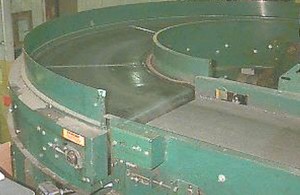
Sometimes, it becomes necessary to convey product around curves or around curves and up to another level. This is accomplished by use of a spiral belt or flat belt turn.
Spiral Belt Turn – The spiral belt turn conveys a product around a turn and up or down between different elevations. Product spacing and orientation are maintained from beginning to end of the turn.
Flat Belt Turn – The flat belt turn is a motorized conveyor unit for moving product around a curve without relying on momentum or pressure from the follow-on products. From the beginning to end of the turn, the unit transports product without changing the product’s relationship to the belt while maintaining the same distance between products.
For more information about conveyor belt and sortation systems, visit our Conveyor Basics page at //www.techtransfer.com/resources/wiki/entry/752/. For information related specifically to safety and preventive maintenance, visit our Conveyor Safety and Preventive Maintenance page at //www.techtransfer.com/resources/wiki/entry/754/

